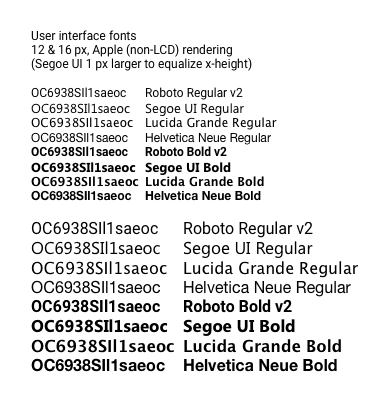Wired magazine’s puff-piece on Google’s Roboto typeface revisions is really bothering me. I thought if I held off, I could just do a few sarcastic tweets and be done with it, but no.
I am not a huge Roboto-hater like some folks in the type community. I just object to uncritically publishing quotes that make blatantly false statements.
“UIs [user interfaces] are crafted from images and type,” Matias Duarte, Android’s head of design tells WIRED. “But the idea of having a typeface that’s thought out as a UI typeface—that’s not been done before.”
Well, that’s pretty much simply false. (UPDATE: Duarte says he thinks he was misquoted, basically he was trying to just say UI typefaces are hard, and Roboto had a particular challenge in needing to work in a wide range of contexts and types of devices.)
[Perhaps not Duarte, but apparently the Wired author was] unfamiliar both with an obscure operating system called “Windows” and its typefaces Segoe UI (introduced in Windows 7) and Tahoma (introduced in Windows 95), both of which were specifically designed/intended for UI usage. Not to mention Chicago, developed for the original Mac OS back in 1984. (UPDATE: Plus, there is Prelude, designed by David Berlow and Font Bureau as a UI typeface for the Palm Pre operating system—when Duarte himself was in charge of UI for the Pre. Not to mention Android’s own Droid Sans, also designed as a UI typeface.)
A slightly weaker argument could be made for Lucida Grande (the Mac OS X UI font), which is only slightly tweaked from Lucida Sans. Of course, Lucida Sans itself was specifically designed for low-res screens and the like. Designer Chuck Bigelow got a MacArthur “Genius” award for his work on the family.
There are seven substantial paragraphs to the article, but both the people quoted are on the Android team. Thus it avoids mentioning the most famous thing anybody has said about Roboto, ever: Stephen “Stewf” Coles calling it a “four-headed Frankenfont” in a strong attack on the design philosophy behind it.
This is also why there is so much puffery throughout the article emphasizing how the typeface is designed for performance rather than aesthetics. Such choices do certainly explain most of the changes from v1 to v2 of Roboto, but “performance over aesthetics” is clearly false as a general proposition about the typeface. My big problem with Roboto is that the choice of closed counterforms for many letters and numbers (35CGSacs) is an inherently anti-legibility choice. Yes, they had more of these before the revision, and some (5) have been slightly improved, but they need to finish the process of transforming it into a different typeface if they want it to be an outstanding UI typeface.
Indeed, I would argue that such closed shapes are stupid bordering on criminal in a user interface typeface. There is a reason that most other typefaces specifically designed for user interfaces have used open counters, and that is because there is massive evidence that tells us these shapes are more legible (see for example the research cited in Sofie Beier’s book on the subject). Legibility should be a the paramount concern for a user interface typeface.
Roboto designer Christian Robertson explains the mix of open and closed shapes as saying that they create an appealing texture in body text. Which is lovely and all, but in a user inferface, that is not as important as legibility.
That said, to be fair, Apple is doing a much worse thing in choosing Helvetica Neue as their UI typeface, first for iOS and soon for the next version of OS X. They too have gone to lengths to declare publicly how they are optimizing it for legibility, which is rather like trying to polish a turd. Helvetica is inherently anti-legibility. The only way to make it otherwise would be to change it so much that it doesn’t look like Helvetica any more. Sadly, that is not what Apple is doing. (Update: Apple later changed to San Francisco, which has the same “modern” look as Helvetica, but with just slightly more open counters… rather like Roboto in that regard.)
Aside from the business of being first with a dedicated custom UI font, if Google and Apple were to explain that they are making their UI font choices for design reasons, that’s fine. But when they (or Wired) start touting the awesome legibility and functionality of their choices, I have to call them out on it. Nonsense.

Leave a Reply